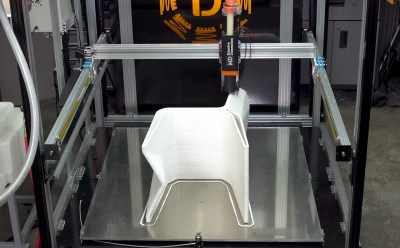The large-format 3D printer is a serious engineering challenge
When you want to build a large format 3D printer, you can't just scale the design of a desktop machine. In an excellent four-part build series (videos after the break), [Dr. D-Flo] tells us about all the technical challenges he faced when building a 3D printer with a build volume of 4x4x4 feet (1.2 cubic meters).
For such a large print volume, you won't be printing with a 0.4mm nozzle. The heart of the printer is a commercial Massive Dimension MDPH2 pellet extruder, capable of extruding around 1kg of plastic per hour through 1.5mm to 5mm nozzles. To power the extruder, [Dr. D-Flo] used a Venturi vacuum system to periodically suck pellets from a large hopper. The system is driven by compressed air, which can introduce moisture into the carefully dried pellets. To reduce humidity levels, compressed air is passed through a series of vertical aluminum tubes to allow moisture to condense and drain out the bottom.
 At 8.4kg, it needs a powerful motion platform to move it. [Dr. D-Flo] went with a fixed bed design, with the extruder pushed by seven high-torque NEMA23 motors on a large gantry constructed from aluminum C-beam extrusions. A machine this size needs to be very rigid with tight-fitting parts, so [Dr. D-Flo] made a extensive use of CNC machined aluminum parts.
At 8.4kg, it needs a powerful motion platform to move it. [Dr. D-Flo] went with a fixed bed design, with the extruder pushed by seven high-torque NEMA23 motors on a large gantry constructed from aluminum C-beam extrusions. A machine this size needs to be very rigid with tight-fitting parts, so [Dr. D-Flo] made a extensive use of CNC machined aluminum parts.
To enable dynamic bed leveling, [Dr. D-Flow] used a Quad Gantry Leveling (GQL) scheme. This means that each of the four Z actuators will dynamically adjust its position based on inputs from the leveling probe. To avoid stressing the corner attachments that hold the X-Y gantry to the Z carriage plates, he used radial spherical bearings at the attachment points to allow a few degrees of play.
The build plate consists of an aluminum plate bolted to the base in 25 positions with springs for adjustment. A massive 6000 watt 220V heating pad sticks to the bottom, while the actual print surface is a large sheet of borosilicate glass. A major concern was build plate deflection when heated to working temperature, but with all tuning options [Dr. D-Flo] was able to obtain a height variation of up to about 0.25 mm. This is within the acceptable range when printing with layer heights of 1mm or greater.
We've featured large-scale 3D printers in the past, but none are as large as the University of Maine's building-sized 3D printer that can print a motorboat in one go. single piece.

When you want to build a large format 3D printer, you can't just scale the design of a desktop machine. In an excellent four-part build series (videos after the break), [Dr. D-Flo] tells us about all the technical challenges he faced when building a 3D printer with a build volume of 4x4x4 feet (1.2 cubic meters).
For such a large print volume, you won't be printing with a 0.4mm nozzle. The heart of the printer is a commercial Massive Dimension MDPH2 pellet extruder, capable of extruding around 1kg of plastic per hour through 1.5mm to 5mm nozzles. To power the extruder, [Dr. D-Flo] used a Venturi vacuum system to periodically suck pellets from a large hopper. The system is driven by compressed air, which can introduce moisture into the carefully dried pellets. To reduce humidity levels, compressed air is passed through a series of vertical aluminum tubes to allow moisture to condense and drain out the bottom.
 At 8.4kg, it needs a powerful motion platform to move it. [Dr. D-Flo] went with a fixed bed design, with the extruder pushed by seven high-torque NEMA23 motors on a large gantry constructed from aluminum C-beam extrusions. A machine this size needs to be very rigid with tight-fitting parts, so [Dr. D-Flo] made a extensive use of CNC machined aluminum parts.
At 8.4kg, it needs a powerful motion platform to move it. [Dr. D-Flo] went with a fixed bed design, with the extruder pushed by seven high-torque NEMA23 motors on a large gantry constructed from aluminum C-beam extrusions. A machine this size needs to be very rigid with tight-fitting parts, so [Dr. D-Flo] made a extensive use of CNC machined aluminum parts.
To enable dynamic bed leveling, [Dr. D-Flow] used a Quad Gantry Leveling (GQL) scheme. This means that each of the four Z actuators will dynamically adjust its position based on inputs from the leveling probe. To avoid stressing the corner attachments that hold the X-Y gantry to the Z carriage plates, he used radial spherical bearings at the attachment points to allow a few degrees of play.
The build plate consists of an aluminum plate bolted to the base in 25 positions with springs for adjustment. A massive 6000 watt 220V heating pad sticks to the bottom, while the actual print surface is a large sheet of borosilicate glass. A major concern was build plate deflection when heated to working temperature, but with all tuning options [Dr. D-Flo] was able to obtain a height variation of up to about 0.25 mm. This is within the acceptable range when printing with layer heights of 1mm or greater.
We've featured large-scale 3D printers in the past, but none are as large as the University of Maine's building-sized 3D printer that can print a motorboat in one go. single piece.
What's Your Reaction?





















